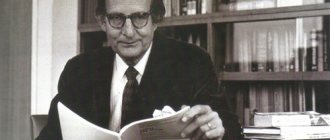The topic to which this article is devoted has been of concern to the global scientific community for several decades - it is directly related to the individual personal characteristics of people.
Everyone knows that the psyche of each person is unique. And this is connected both with the physical and biological characteristics of the organism, and with a complex of social characteristics. If we talk about biologically determined substructures, then, mainly, we need to consider temperament.
What is temperament?
Temperament implies the mental differences of people, which include the depth, intensity and stability of emotions, energy and pace of actions, emotional sensitivity and many other features of mental life. And the problem of temperament today remains controversial and unresolved. But even if we take into account all the diversity of approaches to its study, researchers agree that temperament is the biological foundation on which a person’s personality as a social being is based.
Temperament is a reflection of the dynamic aspects of behavior, which are mainly innate. Its properties are more stable than the properties of other mental characteristics of a person. And its most striking nuance is that the properties of the temperament of one particular person are not combined with each other by chance - they are interconnected naturally and form a certain conglomerate that characterizes the temperament.
To summarize: temperament must be considered as individually unique properties of the psyche that determine the dynamics of an individual’s mental activity; manifested equally in various activities, regardless of its motives, goals and content, and remaining unchanged already in adulthood, and also characterizing in the aggregate the type of temperament.
However, before considering the types of temperament and their features, it should be said that temperament cannot be bad or good, because Each type has its own advantages, and the efforts of any person should be aimed not at correcting its shortcomings, but at effectively applying its advantages in everyday life and activities.
Temperament. Temperament is one of the manifestations of individual psychological characteristics of a person
Temperament is one of the manifestations of individual psychological characteristics of a person. Temperament is understood as individually unique properties of the psyche that determine the dynamics of a person’s mental activity, which are equally manifested in a variety of activities, regardless of its content, goals, motives, remain constant in adulthood and in their mutual connection characterize the type of temperament.
Human temperament manifests itself in different areas of mental activity. It appears especially clearly in the emotional sphere, in the speed and strength of emotional excitability. There are people who are emotionally responsive and impressionable. Even minor events find an emotional response in them. They respond warmly to events in public life and work with enthusiasm and passion. On the other hand, there are people with low excitability and unimpressive people. Only especially important events in social and personal life cause them joy, anger, fear, etc. They treat everyday events without excitement; They work energetically and calmly.
Some quickly establish their attention, quickly think, speak, and remember. And vice versa, there are people whose characteristic feature is the slow, calm flow of mental processes. They think slowly, speak slowly. Their speech is monotonous and unexpressive. Slowness is found in them in other mental processes, as well as in attention. Temperamental differences also manifest themselves in motor skills:
in body movements, gestures, facial expressions. Some people have fast, energetic movements, abundant and sharp gestures, and expressive facial expressions. Others have slow, smooth movements, sparing gestures, and inexpressive facial expressions. The former are characterized by liveliness and mobility, the latter by motor restraint. Temperament affects the characteristics of mood and the nature of its changes. Some people are most often cheerful and cheerful; Their mood changes often and easily, while others are inclined to be lyrical and stable, their changes are smooth. There are people whose mood changes suddenly and unexpectedly.
The nature of mental activity depends on temperament:
1. The speed of occurrence of mental processes and their stability, for example, speed of mind, speed of perception, duration of concentration.
2. Mental tempo and rhythm.
3. Intensity of mental processes - activity of the will, strength of emotions, etc.
4. Direction of mental activity, i.e., focus on certain objects, for example, the desire for new impressions or turning to oneself, to one’s ideas, etc.
Temperament is an individual psychological feature of a person, which manifests itself in the degree of emotional excitability, in the speed and energy of mental processes, in the speed and expressiveness of movements, facial expressions and gestures, and in the characteristics of mood changes. Temperament is the peculiarity of the dynamics of a person’s mental activity.
We can also give the following definition of temperament: the characteristics of an individual in terms of his dynamic characteristics, i.e. speed, tempo and rhythm of mental processes and mental states.
The founder of the doctrine of temperament is considered to be the ancient Greek physician Hippocrates, who lived in the 5th century. BC e. Hippocrates argued that there are four fluids in the human body: yellow bile and black bile, blood and mucus. These liquids are mixed together in a certain proportion. Hippocrates called the proportion or ratio of four liquids when mixed with the ancient Greek word “krasis”. This word was subsequently translated into Latin as temperamentum. The commonly used word “temperament” comes from this Latin term. Hippocrates believed that when four liquids are mixed, one of them can predominate. From predominance in
When a certain liquid is mixed, a type of temperament arises. According to Hippocrates, there are four main types of temperament - choleric, melancholic, phlegmatic and sanguine.
Hippocrates approached the problem of temperaments from a medical point of view. He believed that one or another temperament creates a predisposition to a certain kind of disease. The teachings of Hippocrates in their content corresponded to the level of development of the sciences of his time and have long been outdated. However, the name of Hippocrates will always live in the history of the science of temperament. His merit is that he was the first to put forward the idea of temperament, which has existed for over two and a half thousand years.
The terms introduced by Hippocrates to designate certain types of temperament turned out to be tenacious: choleric, melancholic, phlegmatic. Words such as “temperament” and “sanguine”, although they do not belong to Hippocrates himself, their appearance in science is associated with his teaching.
Hippocrates' teaching on temperament aroused great interest in this problem among ancient scientists - philosophers and doctors. Already in ancient times, many different teachings about temperament appeared (Aristotle, Galen, etc.). Some of them argued that a person’s mental qualities also depend on temperament.
The founder of psychological teachings about temperament is the German philosopher I. Kant. His vividly written characteristics of the four temperaments (sanguine, melancholic, choleric and phlegmatic) have long been considered classic and had a great influence on the development of teachings about temperament in empirical psychology. Kant's teaching on temperament and numerous theories of temperament created by empirical psychologists are based on idealistic philosophy and cannot be considered scientific.
In addition to psychological theories of temperament, many others have been created - chemical, physical, physiological. Some scientists looked for the basis of temperament in the chemical composition of the body and blood. Others - in the movement of tissue molecules; still others - in the nature of metabolism in the body, in the speed and force of blood movement in the vessels, in the activity of the endocrine glands, etc.
E. Kretschmer in 1921 proposed to consider the dependence of the psyche on the type of physique. This is a constitutional typology.
Four constitutional types have been identified:
1. Leptosomatic
– characterized by a fragile physique, tall stature, and a flat chest. The shoulders are narrow, the lower limbs are long and thin.
2. Picnic
- a person with pronounced adipose tissue, excessively obese and clumsy, characterized by small or medium height, a bloated body with a large belly and a round head on a short neck.
3. Athletic
- a person with developed muscles, a strong physique, broad shoulders, narrow hips.
4. Displastic
– a person with a shapeless, irregular structure (disproportionate physique, etc.).
Kretschmer correlates the three types of temperament he identified with the named types of body structure: schizothymic
(closed, stubborn, inactive);
ixothymic
(calm, unimpressive, with low flexibility of thinking);
cyclothymic
(his emotions fluctuate between joy and sadness, he easily contacts people and is realistic in his views).
In the 40s XX century W. Sheldon also developed his constitutional concept of temperament. It should be noted that in psychological science, most constitutional concepts have become the object of sharp criticism.
The famous psychologist H. Eysenck believes that a person’s personality includes four levels: I – the level of individual reactions; II – level of habitual reactions; III – level of individual personality traits; IV – level of typical traits: intro-extroversion, emotional instability (neuroticism), psychopathic traits, intelligence.
Neuroticism
–
this is emotional and psychological instability, susceptibility to psychological trauma.
People with increased neuroticism, due to excessive impressionability and touchiness, may experience emotional stress even over trifles. They experience conflicts for a long time, “can’t pull themselves together,” are often depressed, sad, irritable, anxious, and their circle of friends usually shrinks. These traits are quite persistent and can be smoothed out in the process of persistent self-education.
Extraversion in combination with increased neuroticism determines the manifestation of choleric temperament; “introversion plus neuroticism” determines the temperament of a melancholic person; the opposite of neuroticism is emotional stability, balance, combined with extraversion, manifested as a sanguine type.
A scientific solution to the problem of temperaments became possible only thanks to the teachings of I. P. Pavlov on the types of higher nervous activity.
Temperament is those innate human characteristics that determine the dynamic characteristics of the intensity and speed of reaction, the degree of emotional excitability and balance, and the characteristics of adaptation to the environment.
There are no good or bad temperaments - each of them has its own positive sides, so the main efforts should not be aimed at changing the temperament (which is impossible due to its innateness), but at the reasonable use of advantages and leveling out the negative sides.
Humanity has long tried to identify the typical features of the mental make-up of various people, to reduce them to a small number of generalized portraits - types of temperament. Typologies of this kind were practically useful, since with their help it was possible to predict the behavior of people of a certain temperament in specific life situations.
Excitation
– this is a property of living organisms, an active response of excitable tissue to irritation. For the nervous system, excitation is the main function. The cells that form the nervous system have the property of conducting excitation from the area where it originated to other areas and to neighboring cells. Thanks to this, nerve cells acquired the ability to transmit signals from one body structure to another. Excitation became a carrier of information about the properties of stimuli coming from outside and, together with inhibition, a regulator of the activity of all organs and systems of the body. The process of excitation occurs only at a certain intensity of the external stimulus, exceeding the absolute threshold of excitation characteristic of a given organ.
In the course of evolution, along with the complication of the nervous system, methods of transmitting excitation have also been improved, in which this process extends to the end of the path without any weakening, which allows excitation to carry out a regulatory function in the whole organism. The process of excitation, together with inhibition, forms the basis of higher nervous activity. Their dynamics leave their mark on all acts of behavior, even the most complex, and their individual characteristics determine the type of higher nervous activity.
Braking
- this is an active process, continuously associated with excitation, leading to a delay in the activity of nervous processes or working organs.
In the first case, inhibition is called central,
in the second -
peripheral.
Peripheral inhibition was discovered in 1840 by the Weber brothers, who obtained cardiac arrest by rhythmic stimulation of the vagus nerve. Central braking is open I.M. Sechenov in 1863. This discovery had a profound impact on the study of not only neurodynamics, but also the regulation of mental processes.
Currently, two different methods of inhibition of cellular activity have been identified: it can either be the result of activation of special inhibitory structures, or arise as a consequence of preliminary excitation of the cell.
The mobility of an animal's nervous processes in laboratory conditions is determined by converting a positive reflex into an inhibitory one and vice versa. If in a number of experiments the sound stimulus is reinforced with the action of an unconditioned stimulus (food), but the light stimulus is not reinforced, then the animal will develop a positive conditioned reflex to the sound and an inhibitory one to the light. If in subsequent experiments we do the opposite: the light stimulus is reinforced by the action of the unconditioned (food), but the sound stimulus is not reinforced, then a transformation of the positive conditioned reflex into an inhibitory one and the inhibitory one into a positive one should occur. In animals with a mobile nervous system, such alteration is carried out relatively quickly and painlessly; For animals with a sedentary nervous system, such alterations are given with great difficulty. The speed and ease of converting positive conditioned reflexes into inhibitory and inhibitory into positive ones is an indicator of the mobility of nervous processes. Based on mobility, the nervous system can be mobile or inert.
The mobile nervous system is characterized by the rapid occurrence of nervous processes, a quick and easy change from the process of excitation to the process of inhibition and vice versa. A characteristic feature of the inert nervous system is the relatively slow occurrence of the main nervous processes - excitation and inhibition and the difficulty of their mutual change.
Depending on the unique combination of these three basic properties of nervous processes - strength, balance and mobility, unique types of the nervous system arise.
Emphasizing the possibility of a wide variety of combinations of the basic properties of the nervous processes of strength, balance and mobility, I.P. Pavlov argued that four variants of these properties are most often encountered in life. They determine four main types of higher nervous activity.
A scientific explanation of the nature of temperament was given by I.P. Pavlov in the doctrine of the basic properties of the nervous system. Studying the higher nervous activity of animals, he found that dogs, differing in the nature of the formation and course of conditioned reflexes, also differ in temperament. On this basis, he came to the conclusion that the basis of temperament is the same reasons as the basis of the individual characteristics of conditioned reflex activity, namely the properties of the nervous system - the primary signs.
The type of higher nervous activity, according to Pavlov, is a combination of the basic properties of the nervous system (strength, balance and mobility), which determines the individual characteristics of nervous conditioned reflex activity and temperament.
Under the power of nervous processes I.P. Pavlov understood the performance of nerve cells, their ability to withstand prolonged stress without falling into an inhibitory state (exorbitant inhibition).
The strength of the process of excitation and inhibition is determined by the performance of nerve cells.
A strong nervous system is characterized by high rates of excitation or inhibition. High levels of excitation strength determine the endurance and performance of the nervous system in relation to the excitation process. Endurance and performance regarding the braking process provide high levels of braking strength. A strong nervous system is able to withstand great stress, but a weak nervous system cannot withstand such stress, going into a state of extreme inhibition.
A derived property, put by I.P. Pavlov in the definition of the type of higher nervous activity, is the balance of nervous processes - excitation and inhibition, the degree of correlation between the indicators of the strength of excitation and the strength of inhibition, or their balance.
Equilibrium follows from the equality of the indicators of the processes of excitation and inhibition in strength, and such a nervous system is balanced. If one of the nervous processes prevails over the other in strength, then such a nervous system will be unbalanced.
The property that determines the type of higher nervous activity is the mobility of the basic nervous processes
–
excitation and inhibition, i.e. the rate of change from excitation to inhibition, and vice versa.
The nervous system of humans and animals is constantly exposed to environmental influences, which are characterized by inconstancy and variability. The balance of the organism with the environment is achieved only if both nervous processes - excitation and inhibition - keep up with fluctuations in the environment in terms of speed and speed of change. I.P. Pavlov defines the mobility of nervous processes as the ability to “quickly, at the request of external conditions, give way, give preference to one irritation over another, irritation before inhibition and vice versa.”
Physiological characteristics can be presented as follows: Type I
–
strong, balanced, agile;
Type II –
strong, unbalanced;
Type III –
strong, balanced, inert;
Type IV –
weak.
I. P. Pavlov always approached the question of the possibility of transferring data obtained through experiments on animals to humans with caution. However, he considered it possible to extend the doctrine of the types of higher nervous activity to humans. I.P. Pavlov believed that the type of higher nervous activity is manifested in the behavior and activity of animals and humans. I. P. Pavlov called the imprint that the type of higher nervous activity leaves on human behavior and activity temperament and drew a parallel between the four main types of higher nervous activity and temperaments, the existence of which was first noticed by Hippocrates.
In addition to these basic temperaments, there are many other individual or mixed ones. The most studied in psychology are the four main temperaments; individual, or mixed, temperaments have not been sufficiently studied.
Temperament properties:
1. Sensitivity
is determined by what is the smallest force of external influences necessary for the occurrence of any mental reaction in a person, and what is the speed of occurrence of this reaction.
2. Reactivity
characterized by the degree of involuntary reactions to external or internal influences of the same strength (a critical remark, an offensive word, a harsh tone, even a sound).
3. Activity
indicates how intensely (energetically) a person influences the outside world and overcomes obstacles in achieving goals (perseverance, focus, concentration).
4. Relationship between reactivity and activity
determines what human activity largely depends on; from random external or internal circumstances (mood, random events) or from goals, intentions, beliefs. Plasticity and frigidity indicate how easily and flexibly a person adapts to external influences (plasticity) or how inert and rigid his behavior is. Rate of reaction, characteristic speed of various mental reactions and processes, rate of speech, dynamics of gestures, speed of mind.
5. Rate of reactions.
We judge this property by the speed of various mental reactions and processes, i.e. speed of movements, rate of speech, speed of memorization, quickness of mind, resourcefulness.
6. Plastic
–
rigidity.
The ease and flexibility of a person’s adaptation to external influences is plasticity. Rigidity – inertia, rigidity of behavior, habits, judgments.
7. Extroversion, introversion
determine on what a person’s reactions and activities primarily depend - on external impressions arising at the moment (extrovert), or on images, ideas and thoughts associated with the past and future (introvert).
8. Emotional excitability.
How weak an impact is necessary for an emotional reaction to occur and at what speed it occurs.
The psychological characteristics of the main types of temperament follow from its psychological essence and are closely related to its definition. They reveal the characteristics of emotional excitability, the speed and energy of mental processes, the characteristics of motor skills, the nature of the prevailing moods and the characteristics of their change. The characteristics reveal the unique dynamics of a person’s mental activity, determined by the corresponding type of higher nervous activity.
Considering the above, the psychological characteristics of the main types of temperaments can be presented as follows:
1. Sanguine temperament, which is based on a strong, balanced, mobile type of higher nervous activity, is characterized by mild emotional excitability, rapid occurrence of mental processes, fast, numerous, varied movements, an abundance of light, graceful gestures, rich facial expressions, a predominance of a cheerful, cheerful mood , quick, painless change of mood.
2. Choleric temperament, which is based on a strong, unbalanced (with a predominance in the strength of the excitation process), mobile type of higher nervous activity, from the psychological side it is characterized by increased emotional excitability, rapid, energetic course of mental processes, fast, energetic movements, sharp gestures, expressive facial expressions, a stable cheerful mood and a sharp transition from one mood to another.
3. Phlegmatic temperament, which is based on a strong, balanced, inert type of higher nervous activity. Characterized by the following features: reduced emotional excitability; slow, calm flow of mental processes; slow, few movements, rare, inexpressive gestures, inexpressive facial expressions; even, stable moods and their slow and smooth change.
4. Melancholic temperament, which is based on a weak type of nervous system, is characterized by high emotional excitability (impressionability), asthenic feelings, slow mental processes, relatively quick fatigue, slow movements, weak facial expressions, few, low-energy and weakly expressed gestures, a tendency to sad lyrical moods, slow changes in mood.
Research by B. M. Teplov and V. D. Nebylitsin showed that the structure of the basic properties of the nervous system is much more complex, and the number of combinations is much greater than previously imagined. However, these four types of temperament, as the most general ones, can be used to study individuality. According to V.D. Nebylitsin, the so-called inhibitory type is distinguished, characterized by strength, mobility, imbalance, with a predominance in the strength of the braking process.
Creation of typologies of temperament
Since ancient times, people have strived to understand and identify the typical mental characteristics of different people and unite them into a small number of generalizing models. It was these models that were called temperament types; moreover, they were very practical, because through them it was possible to predict the behavior of a person with a certain type of temperament in a specific life situation.
It is officially believed that the doctrine of temperament in general was created by the ancient Greek physician Hippocrates, who argued that people are distinguished by four main “body juices” - blood, phlegm, yellow bile and black bile. Following the teachings of Hippocrates, the equally famous physician of antiquity, Claudius Galen, created the first typology of temperaments of its kind and outlined it in his treatise “De Temperamentum”. According to his ideas, the type of temperament depends on what type of “juice” predominates in the human body. It was Galen who identified four known types of temperament: melancholic (black bile predominates), choleric (yellow bile predominates), phlegmatic (phlegm predominates) and sanguine (blood predominates). The presented concept has been of great importance to scientists for many centuries.
History of the study and theory of temperament
V.M. Rusalov wrote: “The study of temperament has a complex and contradictory history. It is unlikely that there is such a fundamental concept in psychology that would be so well understood by everyone at the level of common sense, but in fact would be so little studied, despite the numerous publications devoted to it” [50]. To date, the situation has not changed: temperament is still one of the insufficiently studied mental phenomena.
Let us consider the main historical stages in the development of scientific ideas about human temperament.
Humoral theories of temperament . The concept of “temperament” arose on the basis of the teachings of the famous ancient Greek physician Hippocrates (VI-V centuries BC), according to which the level of vital activity of the body is determined by the relationship between the four fluids circulating in the human body - blood, bile, black bile and mucus ( lymph, phlegm). The ratio of these fluids varies from person to person.
It is from the theory of Hippocrates that the term “temperament” originates, coming from the Latin “temperamentum”, which translated means “proportionality, proper relationship of traits” [27, 30, 33].
Based on the teachings of Hippocrates, another famous physician of antiquity, Claudius Galen (2nd century BC), developed a typology of temperaments, which he outlined in the treatise “De temperamentum”. According to his teaching, the type of temperament depends on the predominance of one of the juices in the body. Depending on the hypothetical predominance of one of the juices, Galen identified and gave names to four types of human temperament: sanguine (from the Latin sanguis - blood), phlegmatic (from the German phlegma - mucus, phlegm), choleric (from the Greek chole - bile) and melancholic (from the Greek melas chole - black bile). For each type of temperament, Galen compiled a psychological portrait.
The concept of Hippocrates and Galen had a huge influence on scientists for several centuries, until the 19th century. Other scientists (Aristotle, Lesgaft, etc.) associated the characteristics of temperament with other features of the circulatory system - the speed of coagulation and blood density, the thickness and elasticity of the walls of blood vessels, the diameter of their lumen, the structure and shape of the heart [26, 33].
The last prominent representative of humoral theories of temperament is I. Kant, who in 1879 proposed semi-scientific, semi-artistic descriptions of temperament types, the organic basis of which he also considered the characteristics of blood.
Constitutional-typological theories of temperament . In 1921, the work of the German psychiatrist E. Kretschmer “Body Structure and Character” [21] was published, which presented a new look at the nature of temperament. Based on the results of clinical studies, Kretschmer linked human temperament with individual differences in physique - body shape, its proportions, height, weight, amount of body fat. According to Kretschmer, each specific human body type corresponds to certain psychological characteristics.
After taking many measurements of patients’ body parts, Kretschmer came to the conclusion that there are four human body types [17, 27]:
- Asthenic (leptosomal) (from the Greek asthenes - weak, leptos - fragile, soma - body) body type is characterized, first of all, by a combination of average height in height and weak height in width, which makes people of this type seem taller than they really are . His overall picture is of a thin man with narrow shoulders, thin arms and hands, a long and narrow chest, and a belly devoid of fat. The face of an asthenic person is usually long, narrow and pale; in the profile there is a sharp discrepancy between the elongated nose and the small lower jaw, and therefore it is called angular in shape.
- Pyknic (from the Greek pyknos - dense) is distinguished by the strong development of the internal cavities of the body (head, chest, abdomen) - with a weak motor system (shoulder girdle and limbs). Picnics are people of average height and with a dense figure, their deep sash chest goes into a massive, obese-prone abdomen, which is a kind of center of this body type (compared to the shoulder girdle of athletes). The frontal outline of the face resembles a pentagon (due to fat deposits on the lateral surfaces of the jaws), while the face itself is wide, soft, and rounded.
- The athletic (from the Greek athletes - wrestler) type is distinguished by the strong development of the skeleton and muscles, the width of the torso is significantly reduced downwards. People of this type have medium or tall height, broad shoulders, a stately chest, and an elastic stomach. The head of athletes is dense and high, it is supported directly on a strong, free neck, and the face usually has an elongated ovoid shape.
- Dysplastic (from the Greek dys - bad, plastis - formed) - characterized by a shapeless, irregular structure, various deformations of the physique (for example, excessive growth, disproportionate physique).
Each of the listed body types, according to Kretschmer, corresponds to a certain type of temperament:
- Schizothymic temperament corresponds to the asthenic (leptosomal) body type. Characterized by isolation to the point of autism, fluctuations in emotions from irritation to dryness, stubbornness, intractability to persuasion and change of attitudes, difficulties in adapting to the environment, and a tendency toward abstraction. With mental disorders, a predisposition to schizophrenia is detected.
- Cyclothymic – corresponds to the pyknic body type. It is characterized by qualities opposite to the characteristics of the schizothymic temperament: it easily contacts the environment, emotions fluctuate between joy and sadness, cheerfulness and gloom. In some cycloids, the center of these oscillations is directed towards the hypomanic pole, in others - towards the depressive pole. In mental disorders, a tendency towards manic-depressive psychosis is found.
- Ixothymic temperament – corresponds to the athletic type of temperament. An ixothymic person is calm, unimpressive, has restrained gestures and facial expressions, low flexibility of thinking, and has difficulty adapting to changes in the environment. In mental disorders, it shows a predisposition to epilepsy.
Kretschmer also identified four groups of qualities associated with human temperament:
- psychesthesia – excessive sensitivity or insensitivity to mental stimuli;
- mood background - a shade of pleasure or displeasure in mental experiences, noted on the cheerful-sad scale;
- mental tempo - acceleration or delay of mental processes in general and their special rhythm;
- general motor tempo - mobility or retardation, special nature of movements (fast, soft, rounded, etc.).
Kretschmer believed that the relationship between a person’s physique and temperament is due to the influence of the body’s endocrine system on both: “Temperaments..., as we firmly know empirically, are humorally determined by the chemistry of the blood. Their bodily representative is the apparatus of the brain and glands. Temperaments constitute that part of the psyche that, probably along the humoral path, is in correlation with the structure of the body. ... the brain remains the final organ for all actions related to temperament, even those that come from the chemistry of the blood. Experimental observations of brain injury indicate that direct effects on the brain can cause dramatic changes in temperament. This obvious fact should be especially emphasized so as not to fall again from anatomical one-sidedness into humoral one-sidedness, especially since with modern trends such a danger exists” [21].
Kretschmer's theory became widespread in Europe, and developed in the United States in the 1940s. the concept of temperament of the American doctor and psychologist W. Sheldon, similar to Kretschmer’s theory. Based on embryology on the one hand, and using specially developed photographic techniques and complex anthropometric measurements on the other, Sheldon came to the conclusion that human temperament depends on the predominant development of one of the three tissues originating from the three germinal petals of the embryo. In accordance with this, Sheldon identified three types of human body structure [17, 27, 36, 40]:
- Endomorphic (mainly internal organs are formed from the endoderm) - a relatively weak physique with excess adipose tissue - corresponds to the pyknic body type in the Kretschmer classification.
- Mesomorphic (muscle tissue is formed from the mesoderm) – a slender and strong body, great physical strength – corresponds to the athletic body type in Kretschmer’s typology.
- Ectomorphic (skin and nervous tissue develop from the ectoderm) - fragile physique, flat chest and long thin limbs with weak muscles - asthenic (leptosomal) type according to the Kretschmer classification.
Empirically, Sheldon discovered that the listed types of body structure correspond to certain types of temperament, to which he gave the following names [33, 50]:
- Viscerotonic (from Latin viscera - insides) - corresponds to the endomorphic body type. Characterized by a lively, sociable temperament, love of comfort, with sensual aspirations, relaxation and slow reactions.
- Somatotonic (from the Greek soma - body) - corresponds to the mesomorphic type of body structure. Characterized by a love of adventure, a penchant for risk and competition, a thirst for muscular action, activity, courage, and aggressiveness.
- Cerebrotonic (from Latin cerebrum - brain) - corresponds to the ectomorphic type of body structure. Characterized by a craving for aesthetic pleasures, coldness, low sociability, a tendency toward isolation and loneliness, and increased reactivity.
Thus, the theories of temperament of Kretschmer and Sheldon in general have a large number of similarities. However, both concepts have been criticized. The disadvantage of Kretschmer’s theory was seen in the fact that the data obtained on a group of mentally ill people were transferred to healthy people without sufficient grounds [37], and the disadvantage of both theories was considered the idea of “fatal somatic conditioning of a wide variety of mental personality traits, including such which are entirely determined by the conditions of upbringing and the social environment” [33].
Neurodynamic theories of temperament . A new approach to the study of temperament was developed in the 1920s and 1930s. outstanding Russian physiologist, Nobel Prize laureate I.P. Pavlov. Pavlov studied the higher nervous activity of living organisms, conducting numerous experiments on dogs. As a result of these experiments, he came to the conclusion that temperament is based not on the properties of fluids or bodily tissues, but on the peculiarities of the functioning of the nervous system, namely, the properties of the nervous processes of excitation and inhibition.
“Long-term laboratory observation,” writes I.P. Pavlov, and the study of a huge number of dogs using the method of conditioned reflexes gradually revealed to us these properties in their life manifestations and combinations. These properties are: firstly, the strength of the basic nervous processes - irritable and inhibitory - which constantly constitute integral nervous activity; secondly, the balance of these processes and, finally, thirdly, their mobility. It is obvious that all of them, being present simultaneously, determine the highest adaptation of the animal organism to the surrounding conditions of life, in other words, the perfect balance of the organism as a system with the external environment, i.e., they ensure the existence of the organism. The significance of the strength of the nervous processes is clear from the fact that in the environment there are (more or less often) unusual, extraordinary events, irritations of great strength, and, naturally, the need often arises to suppress, delay the effects of these irritations at the request of others, the same or even more powerful, external conditions. And nerve cells must endure these extreme stresses of their activity. This also implies the importance of balance, the equality of strength of both nervous processes. And since the environment surrounding the organism constantly, and often strongly and unexpectedly, fluctuates, both processes must, so to speak, keep up with these fluctuations, i.e. must have high mobility, the ability to quickly, as required by external conditions, give way, give preference to one irritation over another, irritation before inhibition and vice versa.
Ignoring gradations and taking only extreme cases, the limits of fluctuation: strength and weakness, equality and inequality, lability and inertia of both processes, we already have eight combinations, eight possible complexes of the basic properties of the nervous system, eight of its types. If we add that predominance in cases of imbalance can belong, generally speaking, to either the irritative process or the inhibitory process, and in the case of mobility, inertia or lability can also be a property of either one or the other process - the number of possible combinations already extends to twenty-four" [37 , p.448].
But instead of twenty-four types of the nervous system, Pavlov identifies only four of its main types: “as a result of possible fluctuations in the basic properties of the nervous system and possible combinations of these fluctuations, types of the nervous system should occur and, as arithmetic calculation indicates, at least in quantities of twenty-four, but , as reality shows, in a much smaller number, namely four types that are especially sharp, conspicuous, and most importantly, differ in their adaptability to the environment...
We must recognize the type of weak animals, characterized by a clear weakness of both irritable and inhibitory processes, never fully adapting to life and easily breaking down, quickly and often becoming sick, neurotic, under the influence of difficult life situations... And what is most important: this type, as a rule, cannot be improved to a very significant extent ... only under some especially favorable, special conditions or, as we usually put it, in a greenhouse environment. This type is contrasted with the types of strong animals, but then again differ from each other.
This is, firstly, a strong but unbalanced type, having a strong irritative process, but with an inhibitory process lagging behind in strength, sometimes very significantly, and as a result of this, also easily susceptible to illness when inhibition is required. This is primarily an exclusively combat type, but not a type of everyday life with all its contingencies and requirements. But, being strong, he is still able to discipline himself to a very large extent, improving his initially insufficient inhibition. Until now, in Russian we call him the excitable type, but to avoid misunderstandings and confusion, it is better to designate him with the adjective unrestrained, which directly emphasizes his shortcoming, but at the same time instructs us to see him as a strong type.
From this strong type, strong and balanced animals must be separated.
But in turn, these too differ sharply from each other in their external behavior and, as we now know, specifically due to the mobility of nervous processes. To designate these strong and balanced types, it is legitimate to give adjectives corresponding to their mobility: calm and lively.
These are the main types that exactly correspond to the ancient classification of the so-called human temperaments: melancholic, choleric, phlegmatic and sanguine.
As for smaller variations, they occur, as already said, especially in the weak type, but we have not yet fully studied or systematized” [37, pp. 464-465].
Thus, I.P. Pavlov identified three main properties of nervous processes and four types of temperament based on a combination of these properties. He attributed the properties of the nervous system to:
- The strength of nervous processes, distinguishing between the strength of the excitation process and the strength of the inhibition process. The strength of excitation reflects the performance of the nerve cell and manifests itself in functional endurance, i.e. in the ability to withstand long-term or short-term, but strong excitation, without passing into the opposite state of inhibition. The power of inhibition is understood as the functional performance of the nervous system during the implementation of inhibition and is manifested in the ability to form various inhibitory conditioned reactions.
- The balance of nervous processes is the balance of the processes of excitation and inhibition. The ratio of the strength of both processes decides whether a given individual is balanced or unbalanced, when the strength of one process exceeds the strength of the other.
- The mobility of nervous processes is manifested in the speed of transition from one nervous process to another. The mobility of nervous processes is manifested in the ability to change behavior in accordance with changing living conditions. A measure of this property of the nervous system is the speed of transition from one action to another, from a passive state to an active one, and vice versa. The opposite of mobility is the inertia of nervous processes. The nervous system is more inert the more time or effort it takes to move from one process to another.
In turn, to the types of temperament corresponding to combinations of properties of nervous processes, I.P. Pavlov said:
- Choleric type (uncontrolled): strong unbalanced nervous system;
- Sanguine type (balanced): strong, balanced, mobile nervous system.
- Phlegmatic type (inert): strong balanced inert nervous system.
- Melancholic type (weak, inhibitory): weak nervous system.
The properties and types of the nervous system identified in animals by I.P. Pavlov suggested transferring it to people.
Studying the properties of the nervous system, which Pavlov considered innate, he came to the conclusion that behavior is determined not only by the innate characteristics of the nervous system, but also by the influences to which the body is exposed throughout life: “The behavior of humans and animals is determined not only by the natural properties of the nervous system, but also by those influences that fell and are constantly falling on the body during its individual existence, that is, it depends on constant upbringing or training in the broadest sense of these words. And this is because, next to the above-mentioned properties of the nervous system, its most important property constantly appears - the highest plasticity. Consequently, if we are talking about the natural type of the nervous system, then it is necessary to take into account all the influences that the given organism has been under since birth and is now under” [37, p.449].
Further studies of the properties of the nervous system and temperament in the neurodynamic direction developed Pavlov's theory. In the 1950s as a result of research conducted under the leadership of B.M. Teplov and then V.D. Nebylitsyn, two more properties of nervous processes were discovered [24, 36]:
- Lability of the nervous system - manifests itself in the speed of occurrence and cessation of nervous processes.
- The dynamism of nervous processes is manifested in the ease and speed of the formation of positive (dynamic excitation) and inhibitory (dynamic inhibition) conditioned reflexes.
Subsequently, V.M. Rusalov developed a three-level classification of the properties of the nervous system. It includes [24]:
- General, or systemic, properties that cover the entire human brain and characterize the dynamics of its work as a whole.
- Complex properties manifested in the peculiarities of the work of individual “blocks” of the brain (hemispheres, frontal lobes, analyzers, anatomically and functionally separated subcortical structures, etc.).
- The simplest, or elementary, properties correlated with the work of individual neurons.
The study of the properties of the nervous system continues to this day, however, many temperament researchers subsequently focused their attention on studying the psychology of temperament - its structure and properties.
Next: Structure, properties and types of temperament
Constitutional typologies of temperament
Subsequently, many typologies of temperament were put forward. But the greatest interest is caused by those among them where the properties of temperament, interpreted as innate or hereditary, are associated with individual characteristics in physique. Such typologies are called constitutional (typology by W. Sheldon, typology by E. Kretschmer and others). But, of course, such concepts have been criticized by psychologists. And their main drawback is that they underestimate, and often completely lose sight of, the influence of the environment and social conditions on the formation of a person’s psychological properties.
The theory of I. P. Pavlov
The fact that the course of mental processes and the behavior of an individual depends on the work of the nervous system, which plays a dominant role in the body, has been known for a long time. But the theory of the connection between temperament types and certain general properties of nervous processes was first proposed by the Russian physiologist I. P. Pavlov. It was subsequently developed by his followers.
In the understanding of Academician Pavlov, the type of nervous system is innate and is least subject to any changes under the influence of upbringing or environment. The properties of the nervous system, according to his ideas, form the physiological basis for temperament, which is a mental manifestation of the general type of the nervous system. Pavlov's subsequent studies on animals made it possible to identify types of nervous systems, which he proposed to extend to humans as well.
General psychology test on the topic: Temperament and character
1 Which theories of temperament does W. Sheldon’s theory relate to?
humoral + constitutional behavioral neurodynamic
2 Accentuations are natural options for character development that are not typical: increased vulnerability, decreased ability to socially adapt + increased ability to socially adapt, disruption of the motivational sphere with the dominance of ambivalent states
3. Not a high level of mental activity, slowness of movements, easy fatigue, high emotional sensitivity is characteristic of: sanguine, choleric, phlegmatic + melancholic
4. Personality traits: modesty, self-criticism, selfishness, characterize the individual’s attitude: to other people to activity + to oneself to social and personal responsibility
5. Strong, balanced and mobile type of nervous system behind P.I. Pavlov is typical for: phlegmatic + sanguine choleric melancholic
6. For the first time, a psychological description of “portraits” of various temperaments was given by: Aristotle + Hippocrates I. Kant Plato
7. Strong, unbalanced type of nervous system behind P.I. Pavlov is typical for: + choleric sanguine sanguine phlegmatic melancholic
8. The ability to set goals, act on one’s own initiative and find ways to solve them characterizes a person as: decisive + purposeful, persistent, independent
9. Kretschmer said that isolation, emotional vulnerability, and rapid fatigue are typical for: +asthenics, picnics, athletes, dysplastics
10. The concept of extraversion and introversion was developed by: 3. Freud + K. Young A. Adler C. Rogers
11. The type of temperament that is characterized by slight vulnerability, a tendency to deep experiences, is typical for: + melancholic, choleric, sanguine, phlegmatic
12. Concepts such as: self-criticism, modesty, pride characterize: the attitude of others the individual’s attitude to things + the system of a person’s relationship to himself; features of the course of activity
13. The type of temperament that is distinguished by mobility, sociability and responsiveness is typical for: choleric + sanguine choleric phlegmatic melancholic
14. According to E. Kretschmer, aggressiveness and lust for power characterize; picnic dysplasticity asthenics + athletics
15. Accuracy, thrift and generosity are: traits that manifest themselves in relation to others + traits that characterize a person’s attitude to things; a system of a person’s relationship to himself; traits that manifest an attitude to activity
16. The formal-dynamic side of behavior is characterized by: + temperament orientation mood abilities
17Is it possible to change the type of temperament Yes + No It takes a lot of effort At an early age
18.NN. – a typical representative of the melancholic type of temperament. The formation of which of the character traits will require the least effort from him: determination + gullibility initiative impulsiveness
19. Stable individual personality traits that develop and manifest themselves in activity and communication are: abilities + character, temperament, inclinations
20. One of the authors of the constitutional theory of temperament: I.P. Pavlov + E. Kretschmer I.P. Pavlov J. Guilford L. Thurston.
21. A. is a representative of the sanguine type of temperament. Which character trait is easier to develop in him? + sociability, discipline, responsiveness, hard work
22. A sensitive reaction in response to the force of external influence is an indicator of: reactivity + sensitivity, activity, plasticity and rigidity
23 Natural basis of temperament: brain + type of nervous system dynamic stereotype nervous processes
24 Type of temperament, which is characterized by increased impressionability and touchiness: choleric, sanguine, phlegmatic + melancholic
25 Type of temperament, which is characterized by hot temper and haste in action: + choleric sanguine phlegmatic melancholic
26 What characterizes temperament: +quick involvement in work Politeness neatness hard work
27 What is the character trait for a melancholic temperament: reactivity and activity + emotional excitability, plasticity and rigidity, sensitivity and sensibility
28 The doctrine of the types of higher nervous activity as the physiological basis of temperament belongs to: + Pavlov Ilyin Hippocrates Ukhtomsky
29 A process opposite to excitation, which leads to a slowdown or delay in the conduction of impulses in the nerve centers: + inhibition dynamism melancholy lability
30 Character is + Stable personality traits that determine a person’s attitude towards people, towards himself, towards the work performed
A set of properties that characterize the dynamic features of the course of all mental processes and human behavior, their strength, speed, occurrence, cessation and change
Genetically determined phenomenon
Components of temperament types
Every person has their own type of nervous system. Its manifestations (these are the characteristics of temperament) are an important part of individual psychological differences. The manifestations of any one type of temperament are very diverse; they can be traced in the manner of behavior, and also manifest themselves in the nature of mental activity, actions, sphere of feelings, motives, cognitive activity, characteristics of a person’s speech, etc.
To compose a psychological characteristic of one of the generally accepted types of temperament, they usually resort to the following basic properties:
- Emotional excitability - the speed of occurrence of an emotional reaction and the force of influence necessary for its occurrence;
- Introversion/extroversion – features of the dependence of a person’s reaction and activity. If they depend on external stimuli, then the person is an extrovert, if they depend on internal ones, then he is an introvert;
- Rate of reactions - the speed with which mental reactions and processes occur, speed of mind, rate of speech, etc.;
- Rigidity and plasticity – a person’s ability to adapt to external influences;
- Reactivity - the degree of involuntary reactions to internal or external stimuli of the same intensity;
- Activity – the intensity of a person’s impact on the outside world and the ability to overcome obstacles on the way to achieving a goal;
- The ratio of reactivity and activity is the dependence of human activity on internal or external circumstances, as well as beliefs, intentions, goals;
- Sensitivity is the level of the lowest intensity of external influence necessary for the occurrence of a mental reaction.
In connection with these properties, the outstanding Polish psychologist and doctor of science Jan Streliau gives the most popular characteristics of temperament types.
Currently, science has moved from studying types of temperament to studying its properties. The selection of properties is carried out on the basis of criteria, signs of temperament (V.M. Rusalov):
1) temperament expresses the formal-dynamic nature of behavior (it is not related to the content of the activity and determines the dynamics of the activity);
2) temperament is associated with biological substructures;
3) it is genetically determined, primary;
4) manifests itself early in childhood;
5) temperament is ontogenetically stable, that is, it is stable over certain periods of time. It is the result of development, not education;
6) temperament is cross-situational, that is, it manifests itself in a wide class of situations. It can be studied in various activities;
7) temperament manifests itself more clearly in the most difficult conditions for a person.
Temperament properties are inherent in all people, but with varying degrees of development. In modern psychology, 8 properties are distinguished (BC Merlin, B.M. Teplov, V.D. Nebylitsin): sensitivity, activity, reactivity, balance of activity and reactivity, rate of mental reactions, plasticity-rigidity, emotional excitability, extraversion-introversion.
Sensitivity is a general persistent feature of the nervous system and analyzers, which is expressed in general sensitivity (excitability of attention). It is determined by the strength of the external influence that causes a mental reaction (high sensitivity of the senses, as well as high sensitivity to ongoing events - empathy, anxiety, vulnerability. High sensitivity in melancholic people.
Activity – the degree of energetic influence on the outside world, overcoming obstacles (volitional component). High activity in choleric, sanguine and phlegmatic people and low in melancholic people.
Reactivity – impulsiveness, involuntary movements, reactions to external and internal influences. Manifests itself in the pace, strength and form of response to events. High reactivity in choleric and sanguine people and low in phlegmatic and melancholic people.
The balance of activity and reactivity is determined by what human activity is more dependent on: random, external (mood, random events, etc.) or internal (determination, beliefs, etc.) factors. Sanguine and phlegmatic people are balanced, while choleric and melancholic people are unbalanced.
The pace of mental reactions is the speed of mental processes (movements, speech, perception, etc.). The tempo is high for choleric and sanguine people, low for phlegmatic and melancholic people.
Plasticity-rigidity is the degree of a person’s adaptation to changing circumstances and activities.
Plasticity – flexibility, ease of adaptation to new conditions. Sanguine and choleric people are plastic.
Rigidity (lat. rigiditas - hardness) - inertia, inertia in adapting to new conditions, insensitivity to their changes. Phlegmatic and melancholic people are rigid.
Emotional excitability is the reaction time to emotionally significant and neutral stimuli. How weak influences are necessary for the emergence of emotions and the speed of their occurrence. Emotional excitability is high in melancholic and choleric people, low in sanguine and phlegmatic people.
Extraversion-introversion is the direction of mental activity outward or inward.
Extroversion is an individual personality trait, manifested in the predominant focus of consciousness on the world around us, in increased sociability, initiative, social adaptability, interest in other people, and openness of the inner world. Extroverts are choleric and sanguine.
Introversion is a person’s focus on himself, on his inner world, on his own actions, actions, experiences and thoughts. It manifests itself in unsociability, isolation, lack of interest in others and a tendency to in-depth introspection. Introversion is one of the basic personality traits. Introverts are phlegmatic and melancholic.
Temperament types
According to J. Strelyau, the four main types of temperament are characterized by the following features:
Melancholic
A melancholic person is a person with high sensitivity and low level of reactivity. High sensitivity often leads to the fact that even a minor reason can cause tears. A melancholic person is painfully sensitive and very touchy. He has inexpressive movements and facial expressions, a quiet voice, poor movements, and a low energy level. As a rule, he is timid, unpersistent, unsure of himself, quickly gives up when doing things, has little ability to work and gets tired easily. The attention of such a person is unstable, all mental processes are slowed down. Most melancholic people are introverts.
Choleric
A choleric person is not particularly sensitive, has high activity and reactivity, and reactivity dominates, which is why he is quick-tempered, impatient, unrestrained, unbridled. Facial expressions, gestures and speech are rich and reflect the mood. His aspirations are stable, his interests are unshakable. The choleric person is persistent and sometimes has difficulty switching attention. In the vast majority of cases, choleric people are extroverts.
Phlegmatic person
A phlegmatic person is characterized by high activity, which dominates over low reactivity. He is insensitive and little emotional. External stimuli have a very weak effect on it; able to remain calm in unexpected situations. Also, phlegmatic people have slow and inexpressive movements, the same speech, and poor facial expressions. He has difficulty switching his attention, rebuilds habits and skills very slowly, but he has energy and high performance. Most phlegmatic people are introverts.
Sanguine
A sanguine person is a person with high reactivity, which is on par with activity. It is characterized by lively facial expressions, a wealth of gestures, a quick response to external circumstances, and ease of switching attention. Very sensitive, active, can work for a long time without getting tired. Disciplined, resourceful, has good ability to concentrate and self-control. His interests, moods and hobbies can change quickly. Almost all sanguine people are extroverts.
Summary
As noted above, none of the temperament types are either bad or good. In addition, a person cannot belong to only one single type - he can only have a predominant one, and the rest will be complementary. But, be that as it may, from the perspective of psychological science, types of temperament are only one of the ways of psychological assessment of a personality. You should also be aware that descriptions of temperaments may differ from one specialist to another and include many factors.










